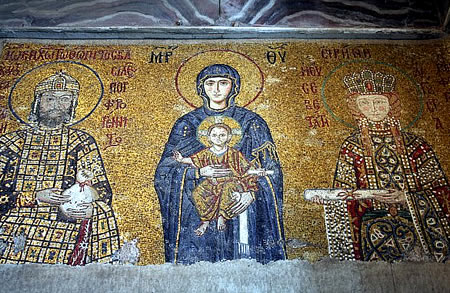 |
| Irene - Princess of Hungary |
Irene of Constantinople (also referred to as Princess Piroska) was the daughter of King Ladislas of Hungary, who ruled from 1077 c.e. He was the son of Béla I of Hungary and Richeza, princess of Poland. Ladislas astutely used the political divisions of 11th century Europe to carve out a position of importance for his kingdom.
His daughter Princess Irene of Hungary became the wife of the Byzantine or Eastern Roman Emperor John II (1087–1143) of the Komnenus (Comnenus) dynasty, whose father was Emperor Alexios I. John II became emperor on the death of his father in 1118.
Irene was born in 1088 in Esztergom, Komarom, Hungary. After her father died, his brother Kalman (Koloman) succeeded him on the throne. King Kalman continued the expansion of Hungary begun by his brother and annexed Croatia to his dominion in 1097.
 |
He arranged Irene’s marriage to John II of the Byzantine Empire, gaining immense reputation from the match. The marriage was beneficial to both states, as it formed an alliance against the Seljuk dynasty of the Turks, who had posed a dangerous threat to the Byzantine Empire since their victory over a Byzantine army at Manzikert in 1071
When Irene went to Constantinople for her royal marriage, she converted from Roman Catholicism to the Greek Orthodox Church in order to marry the emperor. Afterward, she was often referred to as Irene Prisca, which was the name of an earlier saint in the church.
She gained a great reputation for piety toward pilgrims on their way to the Holy Land, especially those coming from her native Hungary. She and her husband founded the church of Saint Savior Pantocrator. The church they built became the largest in Constantinople after the Hagia Sophia.
When Irene was empress the Holy Land was in great peril from the Turks, and Pope Urban II called the First Crusade in 1096 to save Jerusalem. The Byzantine forces of Emperor John, after an initial struggle with the crusaders coming from western Europe, provided invaluable support to them with the large Byzantine navy and their knowledge of siege warfare.
The crusaders conquered Jerusalem in 1099. The crusaders established their own states in the Holy Land and often were in conflict with Emperor John II. In 1137 and 1142 he entered the crusader kingdoms, reaching as far as Antioch, in a show of force to assert his power over them.
By the time of Empress Irene’s death in 1124, only the southern part of the Pantocrator was built, and there she was buried. The Greek Orthodox Church